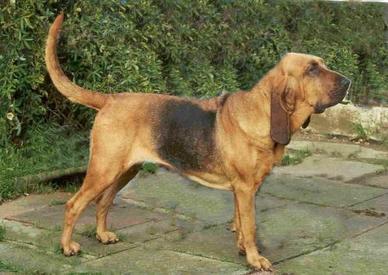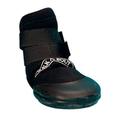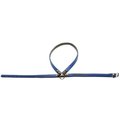
In existence for over 1,000 years, the distinctive Bloodhound, or Flemish Hound, as perfected by monks of Belgium's St. Hubert, was first introduced to Britain from Normandy. The breed's lineage can be traced back to the very first ancient scent tracker and is a direct ancestor of the Talbot Hound, characteristically solid white in colour, and extinct since the 1600s. Renowned for its strong instinct to hunt rather than kill, the Bloodhound relies heavily on its senses, especially on its profound ability to discern scents. For this reason, the Bloodhound was traditionally employed in tracking animals including wild boar and deer, lost children, prisoners and runaway slaves, and today is progressively utilised in policing and detection.
Unique in its appearance, the Bloodhound is easily recognised for its loose expanses of skin, drooping features, long muzzle and sunken eyes. The breed boasts an imposing size and stature and is common in colour variations of black, tan, red and tawny, with a hard textured coat that is easy to maintain. Difficult to obedience train, the breed is easily distracted and becomes determined when following a scent. A pack hound by nature, the Bloodhound enjoys the company of other animals and does not like being left alone for long periods. It matures quickly, growing to its full size within 12 months, so introducing other family pets early is essential, not because the breed is aggressive, but rather, because of its large proportions.
Typically reserved and easy-going with a short, manageable coat, the Bloodhound is a popular breed choice for the modern family, possessing a calm and affectionate temperament that has high compatibility with children. A large breed, the Bloodhound boasts an average weight of 40-56 kg depending on the dog's gender, and has a life expectancy of roughly 10 years when shown appropriate care.
Whilst being generally healthy and resilient, Bloodhounds are particularly susceptible to gastrointestinal complaints which account for the highest number of breed fatalities, including bloat and associated ailments. There are also a high number of documented cases of optical disease in the breed, as well as problems relating to ears and skin.








From North Yorkshire , United Kingdom
I have 3 bloodhounds, father ,mother and son and they are absolutely amazing dogs, we bred one litter because they’re so rare these days in Britain and out of ten pups we couldn’t resist keeping the runt , they are formidable guard dogs, very large , and they sound like a whole pack when the door goes , they love their walks but have to go separately as they definitely get the pack mentality when together, they’re incredibly gentle and fantastic with kids and other dogs , but I wouldn’t recommend to have them around little ones under 4 unsupervised as they are big and clumsy and can knock them flying, also the same with frail elderly people, a bit stubborn too but easy to train when separated, we’ve always had rescues all my life but if I was gonna buy another pedigree again after they’ve all passed then it would have to be a bloodhound again ❤️ Only problem I would say is the eyes and ears can get easily infected if not cleaned regularly, I feel honoured to own them and would recommend this very regal looking dog to anyone 🥰